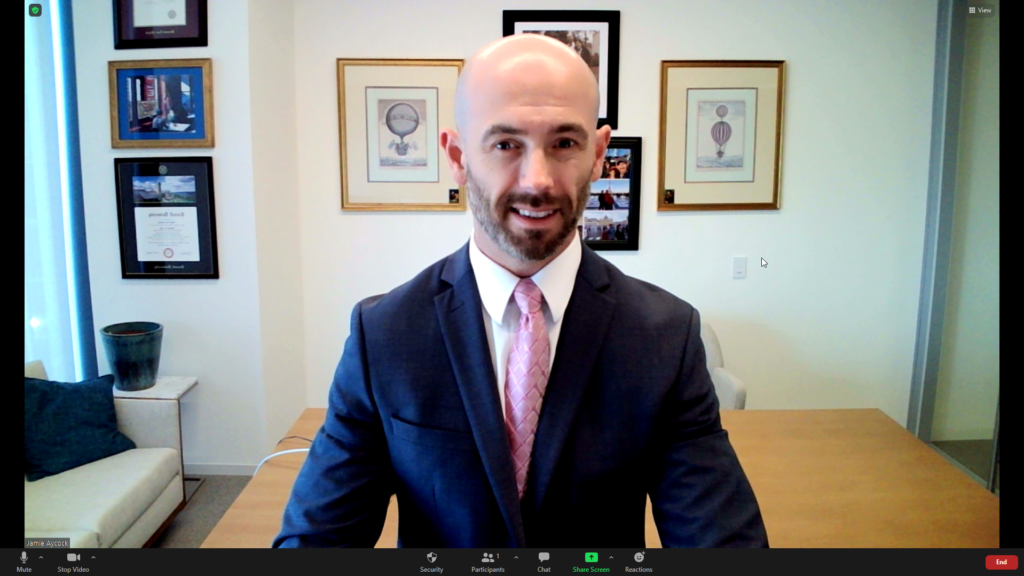
We’re all trying to make the best of virtual everything, constantly trying to improve how we present in this challenging medium. Lots of folks have offered helpful suggestions to improve our virtual presentations, such as how to achieve better lighting or how to make the surrounding room less distracting. If you’re looking for an easy way to give a boost to your performance during Zoom hearings, client meetings or any other presentation, here’s my suggestion: Try standing up.
Simply standing up makes you stand out, boosts your confidence and helps you stay engaged. Sitting can lull you into feeling like you’re just working away at your computer or, even worse, passively watching something happen instead of actively being a part of it.
For me, this started when a colleague had the idea for the first hearing I had early in the Zoom era that we should set up a podium in a conference room to make it feel a little more like a courtroom. I was hooked on standing.
We noticed a huge difference in the professionalism of our presentation compared with our opponents. Since then, I’ve been reading about ways to improve Zoom presentations and have tweaked the distance from the camera and the lighting used. I’ve been surprised that I haven’t seen anyone from any other firm stand during a hearing. A couple of attorneys have told me afterward that they intended to adopt the approach, though, after seeing me and my colleagues.
And you don’t need a podium or a conference room to be able to stand. A standing desk is ideal, but you can create one by stacking your computer or monitor on books or boxes to get to just the right height. It makes sense to have the camera set up so that you can be seen from the waist up. This allows your hand gestures to be visible, means that your face is not pressed so close to the camera that it’s uncomfortable for viewers and makes it possible to position the camera so that any notes you have are in front of you and just out of view. I use a camera with a mic built in that is positioned on top of one my monitors, but there isn’t any reason you couldn’t just use the camera and mic from your laptop.
Stand out
If you stand, you come across as more professional, more in command, more serious. If you’re arguing in court or presenting to the board, you want to look like someone arguing in court or presenting to the board. If you’re sitting, you may look like you’re just along for the ride.
In my view, standing seems to work better regardless of the type of hearing or the role you’re playing. If you’re not an active participate in a hearing, it may make sense to have your camera off. But if you are playing an active role in the hearing, standing puts you in a better position to jump in when appropriate.
In nearly every one of my cases in the last year and a half, at least one person – at times the judge, opposing counsel or client – has commented positively on the fact that I stood up. People notice and appreciate it.
Boost your confidence
Standing puts you in an active position so that you feel prepared to lead. By contrast, sitting is more passive and makes you feel like you have to overcome inertia before you can jump in. When you stand, you have more control over your voice and a greater range for appropriate gestures. You’ll feel the difference and act accordingly.
Stay engaged
Video everything can be exhausting as we try to make the best of faux eye contact and the distractions of seeing ourselves on video. Standing can help, though, by forcing you to stay engaged. It’s a lot harder to droop during the less exciting portions of a presentation when you’re on your feet.
Virtual is always going to be a poor substitute for anything so dependent on interpersonal dynamics as hearings and trials. But standing is one small way you can take advantage of the situation and distinguish yourself.
Jamie Alan Aycock, a litigation partner in the Houston office of Kirkland & Ellis, is a Harvard Law School graduate focusing on high-stakes, complex commercial and restructuring-related litigation for a wide range of industries. Jamie recently was first chair in contested Chapter 11 proceedings for Bouchard Transportation Co. related to its asset sales and for Gulfport Energy Corp. and Extraction Oil & Gas, Inc. in disputes with the Federal Energy Regulatory Commission and midstream companies fighting rejection of contracts. He is currently working on several matters stemming from the Texas freeze in early 2021 and is a member of the Kirkland trial team defending 3M in relation to its combat arms earplug products.
